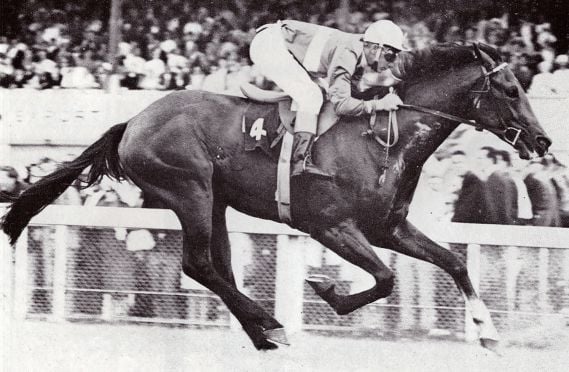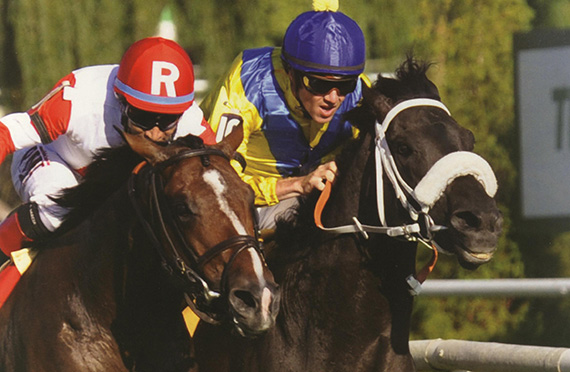The announcement that South African racehorses could soon wing their way direct to the States comes as a tremendous shot in the arm for our beleaguered industry.
Hats off to bloodstock consultant Robin Bruss and shipping agent Gerard Connolly, who succeeded in finding an export portal that will circumvent the arduous and time-consuming trek demanded by the current EU protocol.
Needless to say, those that find themselves crossing the Atlantic will follow in the hoofprints of a number of remarkable South African-breds.
We go back to the sixties to the trailblazing duo of Colorado King and Hawaii.
Both South African champions, they raced with distinction in their adopted country.

Colorado King in action (Pic Credit – Racing Legends)
The former, a Birch-bred who proved himself the dominant two and three-year-old in South Africa, was campaigned on both the west and east coast, winning on dirt and grass.
Successful in six of his first eleven starts, he recorded a fine hat-trick of stakes wins which included an eight-length romp in the American Handicap at Hollywood Park where he equalled the world record over 1800m.
Hawaii too, was an exceptional two and three-year-old, winning 15 of 18 South African starts and to this day, is the only horse to have completed the Cape, Gauteng and SA Guineas treble.

Hawaii
Sent to Hall of Fame trainer MacKenzie Miller, Hawaii went on to win 6 of 10 American starts and ran unplaced just once in his sole dirt start.
The American Grass Champion in 1969, he won the Man O’ War Stakes over 2400m in course and race record time, a mark which stood until 1973 when it was bested by the legendary Secretariat in 1973 and a year later by the great racemare Dahlia.
Retired to the famed Claiborne Farm, Hawaii became a successful sire.
Like their sire, his progeny excelled on grass and he has the distinction of siring an English Derby winner in Henbit, while Hawaiian Sound (2nd) and Hunza Dancer (3rd) both reached the frame in the famed Epsom classic.
Other prominent stars to race in the States all those years ago included two half-brothers to the great Sea Cottage, the Cape Derby and SA Guineas winner Top Galllant and Durban July hero Naval Escort, neither of which set the American tracks on fire, although the former won an allowance race.
Jollify, who deadheated with Sea Cottage in the 1967 Durban July, also found his way to the States, where he ran second in two stakes races, while Cape Guineas winner Shah Abbas scored twice at allowance level before his return to South Africa to take up stud duties.
It wasn’t until the early eighties that prominent South African-breds again tasted success on American soil.
Bold Tropic, the champion two and three-year-old of his year, was sent to legendary Californian trainer Charlie Whittingham. His deft touch with the son of Plum Bold yielded seven wins, of which six were at Stakes level and included the Gr2 Carleton F Burke and two renewals of the Gr2 American Handicap. Although he failed to add a Gr1 win to his tally, his placed efforts in that exalted company included a second in the Gr1 Century Handicap and a third in the Oak Tree Invitational Handicap.

Prince Florimund
Prince Florimund, a dual classic winner of the SA Guineas and Daily News 2000 and conqueror of the mighty Wolf Power in the Clairwood Winter Handicap, likewise joined the Whittingham stable. He managed to win just once but his best effort came in defeat when he was second, beaten just over a length, to the formidable John Henry in the Gr2 American Handicap.
Unlike Bold Tropic, he returned to South Africa and although he never reached great heights as a stallion, he will go down in history as the broodmare sire of the mighty Pocket Power and his Met winning sister River Jetez, who incidentally, ran third in the Gr1 Beverly D Stakes at Arlington Park!
Another twenty years or so would go by before a South African-bred again ventured to the Land of the Free, this being the exceptional Oppenheimer-bred standout Horse Chestnut. Horse of the Year and the country’s first Triple Crown winner, the colt made a dream American debut when he powered to a five-length victory in the Gr3 Broward Stakes at Gulfstream Park. However, that was to be his sole start, as in a cruel twist of fate, he suffered a career-ending injury in a workout. Who knows what heights he could have scaled?
Like Hawaii before him, Horse Chestnut joined the stallion roster at Claiborne and also became a Gr1 sire. He was repatriated after ten seasons and spent his remaining years at Drakenstein Stud, siring the Gr1 winners Chestnuts N Pearls and Tilbury Fort.
Undeterred by Horse Chestnut’s misfortune, trainer Mike de Kock returned to the States in 2013 with champion The Apache and the colt almost pulled off the unthinkable, crossing the line first in the Gr1 Arlington Million, only to lose the race in the boardroom.

The Apache – 2nd after objection in the Gr1 Arlingon Million
Significantly the disqualification robbed the Scott Brothers’ stallion Mogok of a second American Gr1 winner, the stallion’s daughter Gypsy’s Warning having landed Hollywood Park’s Matriarch Stakes in 2010, the first South African-bred filly to win at the elite level in the States.
She was not the first prominent South African-bred female runner to excel in the States though, that honour belongs to the De Kock-trained champion Spook Express, who was sold to overseas interests after defeating Drum Star and Blossoming Fields in the Gr1 Sharp Electronics Cup. Also first across the line first in the Gr1 SA Fillies Guineas and Gr1 Garden Province Stakes, the daughter of Comic Blush was named the season’s Champion three-year-old filly.
She would build on her South African form with three more Graded successes on American soil and had the distinction of chasing home champion Banks Hill (who became the dam of Ideal World) in the 2001 Gr1 Breeders Cup Filly and Mare Turf.
A number of female stakes winners followed, the majority of which were purchased in South Africa by Barry Irwin, the shrewd principal of Team Valor International.
De Kock-trained champion three-year-old Irridescence, who won the Gr1 Woolavington 2000 for Team Valor and emulated London News when successful in the Gr1 Audemars Piguet Queen Elizabeth II Cup at Sha Tin, failed by just a head in the Gr1 Beverly D Stakes.

Crimson Palace
Fellow Team Valor purchase, the Paddock Stakes victress Crimson Palace, succeeded where Irridescence had failed, winning the Beverly D, albeit in the blue silks of Godolphin, who had purchased the daughter of Elliodor after her first Dubai start. Incidentally, she features as the grandam of Syringa Handicap winner Way Of The World, who is out of Crimson Lane, her unraced daughter imported by Brian Finch.
Warning Zone, the champion juvenile filly of 2002, was another ex De Kock-trained filly to earn American black type in the Team Valor silks when successful in a Listed race at Fair Grounds. Sent to Australia, she became the dam of Gr3 winner Pittsburgh Flyer, who in turn produced the Gr1 winning sprinter September Run.
Yet another Team Valor-campaigned American stakes winner was Alexandra Rose, a Gr2 winning juvenile trained by Glen Kotzen.
The daughter of Caesour crowned her American campaign with victory in the Gr3 Monrovia Handicap at Santa Anita and like Warning Zone, found her way to Australia. She has the honour of being the first South African-bred dam of an American Gr1 winner, her Australian-bred daughter Oleksandra defeating male rivals in the Gr1 Jaipur Stakes at Belmont Park.
Cape Fillies Guineas victress Captain’s Lover also raced with distinction in the Team Valor silks when romping to a seven length victory in Monmouth Park’s Matchmaker Stakes. Sadly, she has managed to produce just two foals since her repatriation in 2012. That said, her American-bred daughter Shipboard Romance, the dam of UAE 2000 Guineas third Last Voyage, was imported by Wilgerbosdrift-Mauritzfontein.
Clearly, South African-breds have more than held their own in the ultra-tough arena that is American racing, which augurs well for the likes of Jet Dark and Kommetdieding.
Should they (and who knows, maybe Captain’s Ransom as well) find themselves on a plane bound for New York come 7 March, our hearts and hopes go with them.
May they add to the fine record built by those that have gone before them.
Please click on the cover of the SPRINT to read more:









